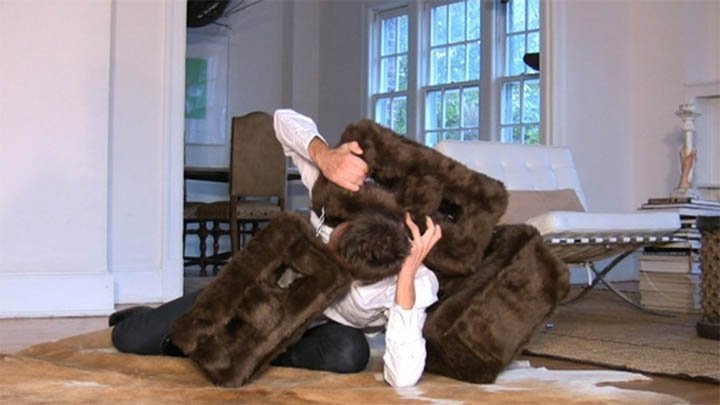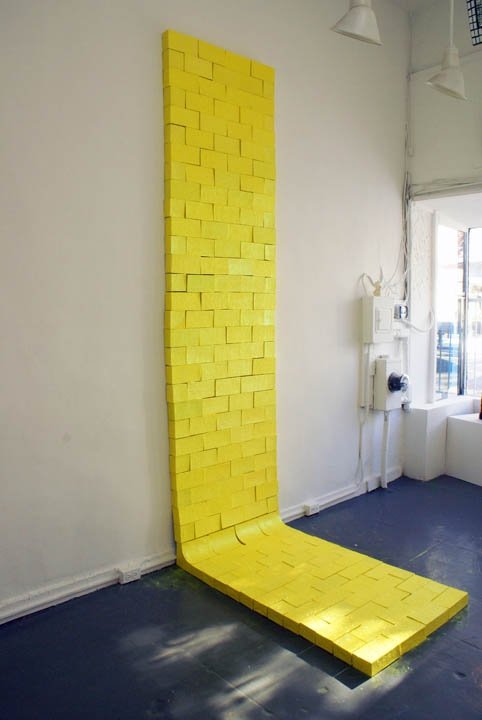Still from Drag, 2009, video, 4:30 minute loop, Ed. of 5
Geoffrey Aldridge :
Hole in the Wall
NOVEMBER 21- DECEMBER 26, 2009
Referencing cultural history and the 40th anniversary of the Stonewall riots, Geoffrey Aldridge: Hole in the Wall at Transformer featured a series of art interventions within our 14th Street, NW project space.
Hole in the Wall artist talk with Geoffrey Aldridge and Nikki Painter, November 21, 2009.
ABOUT THE EXHIBITION
DC-based artist Geoffrey Aldridge utilizes video, sculpture, and spatial interventions to create metaphorical moments of reflection that position relationships between identity construction and gay rights activism. Associating memory, perception, and identity, this installation of works at Transformer created moments of reflection on the continuing struggle of the gay community for recognition and acceptance.
Transformer began working with Geoffrey Aldridge in spring 2009, presenting his brick project as part of Transformer’s participation in NO SOUL FOR SALE – A Festival Of Independents (June 24-28, 2009), hosted by X-initiative at the former Dia Center for the Arts in Chelsea, New York, NY. The brick project was an interactive work that explored the creative and intellectual process of planning, fabricating, and executing an artistic concept from beginning to an unknown outcome.
Timed to take place during Pride Weekend and in celebration of the 40th anniversary of the Stonewall Riots, Geoffrey transformed the Transformer space at X-initiative into a working studio, encouraging the public to engage with his process. Using video, drawing, and sculpture, Geoffrey detailed the process of fabricating yellow brick strap-on shoes, and a plan to place them in the public realm. He then placed the shoes throughout the Greenwich Village neighborhood where the Stonewall Inn is located. Much like the unpredictability of social, cultural and legal processes that gay men and women encounter daily, the brick project raised questions about futility and efficacy.
With Hole in the Wall at Transformer, Geoffrey treated the gallery space like a piece of drawing paper where he plotted, positioned, designed, and articulated the work to create a relationship between the objects and the space which they occupy. Considering these spaces as ‘site-aware’, he is constantly assessing the architectural features as dismissive or affirming. Geoffrey states: “I don’t rely on the architecture to provide resolutions, per se; my interest rests in the ability to create concomitant moments between the objects.”
Investigating identity construction within his work, Geoffrey’s artistic interventions speak to the institutional defining of “identity art” throughout the late ‘80’s and early ‘90’s. Often promoting a stereotypical expectation about artists and their work, Geoffrey positions his work as a continuation of “identity art,” yet specifically from the perspective of a “queer artist,” (a term placed onto him) as conceptually larger than himself.
Geoffrey states: “We all possess gender and sexuality. My interest is within the paradoxical moments between the objects and the viewer—it’s implicative—disrupting, or complicating the space. I want these interactions to work with an in-between-ness sensibility, like a pendulum swinging with two absolutions at either end. I position myself in the center of the swing, a place where I can question.”
Using accessible materials that can be found in any hardware, craft supply, or fabric store, Geoffrey’s intention is to provide the viewer a familiarity or a formal way to access the work. Pendulum, a sculpture consisting of yellow glittered faux bricks, encapsulates Geoffrey’s questioning of ideas on identity in a way that allows the viewer to connect with familiar visual references: “I wanted to formally create an implied swoop or curve. The contrast between a pendulum swinging and the yellow brick road, with parallel implications as a journey or timekeeper, made sense specifically to gay rights activism, past, present, and future. I wasn’t born when Stonewall happened, but I am aware of its importance and my relationship with current gay right activism only because of the pre-existing histories that I believe we have to understand in order to keep building. I don’t want to be redundant.”
Originally from the Midwest, Geoffrey Aldridge received an MFA from American University in 2008. He has been included in national exhibitions such as New American Talent, curated by Nato Thompson, Pulse Miami, and Pulse New York. He is represented by *gogo art projects, Conner Contemporary, in Washington DC where he also lives and works.
Cinder Ball, 2009, cardboard, newspaper, paint, mirror, 16 x 8 x 8
Stole, 2009, cinderblocks, metal chain, faux fur, dimensions variable
Hanky Panky, 2009, video, 14 minute loop, Ed. of 5
Pendulum, 2009, cardboard, newspaper, paint, glitter, 32
Rush, 2009, lightbulbs, electrical wire







